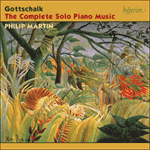
Welcome to Hyperion Records, a British classical label devoted to presenting high-quality recordings of music of all styles and from all periods from the twelfth century to the twenty-first.
Hyperion offers both CDs, and downloads in a number of formats. The site is also available in several languages.
Please use the dropdown buttons to set your preferred options, or use the checkbox to accept the defaults.

No, Gottschalk was not attempting to cash in on writing a companion piece in a similar vein. His ‘grande valse de concert’ has more in common with ‘The Maiden’s Wish’, Liszt’s transcription of Chopin’s song (Zyczenie), though that particular Polish girl is depicted in a mazurka rhythm. Gottschalk’s maiden is a chic Parisienne as portrayed in this charming and self-confident waltz (in E flat). She’s a girl with a winning smile, as the French title suggests—far from the blushing maiden of its mistranslation.
from notes by Jeremy Nicholas © 2003
Non, Gottschalk n’essaie pas ici de tirer profit de ce succès en écrivant une pièce dans la même veine. Sa «grande valse de concert» est plus proche du «Vœu d’une jeune fille», transcription par Liszt d’une mélodie de Chopin (Zyczenie), bien que la jeune fille polonaise en question soit évoquée par un rythme de mazurka. Celle de Gottschalk est une Parisienne chic, à en juger par cette valse (en mi bémol) pleine de charme et d’assurance. C’est une demoiselle au sourire enjôleur, comme le suggère le titre français, et non une jeune fille rougissante, comme le laisse à penser l’erreur de traduction du titre anglais.
extrait des notes rédigées par Jeremy Nicholas © 2003
Français: Josée Bégaud
Nein, Gottschalk versuchte nicht, aus der Komposition eines ähnlichen Stückes Kapital zu schlagen. Vielmehr sind in seinem „grande valse de concert“ Parallelen zu finden mit „Der Wunsch der Jungfrau“, Liszts Bearbeitung eines Chopin-Liedes (Zyczenie), obwohl eben jenes polnische Mädchen mit einem Mazurka-Rhythmus dargestellt wird. Die Jungfrau Gottschalks in diesem selbstsicheren Walzer (in Es-Dur) ist eine elegante Parisienne. Sie ist ein Mädchen mit einem gewinnenden Lächeln, wie der französische Titel annehmen lässt—und nicht, wie die Fehlübersetzung ins Englische suggeriert, eine errötende Jungfrau.
aus dem Begleittext von Jeremy Nicholas © 2003
Deutsch: Viola Scheffel
 Gottschalk: The Complete Solo Piano Music Gottschalk: The Complete Solo Piano MusicWith his idiomatic and graceful style, pianist Philip Martin has established himself as the foremost exponent of Gottschalk. The composer had a unique spontaneity and individuality which Martin’s performances bring vividly to the fore. The complet ...» More |

